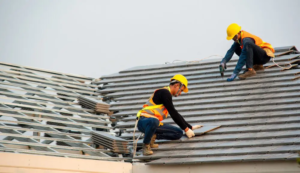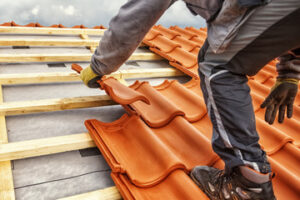The roof is a vital part of any building. It protects interior spaces from rain, snow, sunlight, extreme temperatures, and wind.
Montana Roofing is a physically demanding job that requires a high level of physical fitness and skill. From the start of the day to the end, you will be on a ladder, handling tools and hauling materials up and down.

A home’s roof is more than just a protective barrier. It is also a canvas that can elevate a property’s visual appeal and charm. A beautiful roof speaks volumes about a homeowner’s commitment to quality and aesthetics, and it sends a message of elegance and sophistication to all who enter. Whether it’s the sleek lines of a modern abode or the timeless beauty of a historic landmark, a well-chosen and carefully maintained roof is sure to leave a lasting impression.
To find the right roof aesthetic for your home, explore a variety of styles and materials. Consider the pros and cons of asphalt shingles, metal, tile, and slate roofing to find the best fit for your property and personal style. You can also take inspiration from your surroundings and other homes in your neighborhood to identify design elements that you admire. For example, a herringbone or staggered pattern in the layout of shingles can add visual interest and character to your roof. Other roof design options include green roofs, which combines beauty with sustainability, and solar panels, which offer a contemporary look while harnessing clean energy.
Ultimately, it is important to consult with professional roofers to ensure that the chosen aesthetic is both functional and practical for your unique home or business. In addition, a professional can help you find roofing materials that complement your property’s architectural style, as well as its surrounding environment. Aesthetics also play a role in community and homeowners’ association guidelines, which mandate certain standards for roofs within a particular neighborhood. These guidelines are designed to ensure that all properties in the area share a common aesthetic and contribute to a harmonious and aesthetically pleasing community.
Durability
A roof serves as a protective shield for the interior of a building, so it needs to be able to resist the elements and maintain its structural integrity with minimal maintenance over its functional lifespan. Roofing materials vary in durability, and the choice you make will impact the longevity of your roof, its maintenance costs, and its resale value.
A roofing material’s durability is influenced by a variety of factors, including its composition, the quality of its installation, and prevailing climatic conditions. The most durable roofing materials are able to resist extreme weather and provide protection against leaks and structural damage.
The most common roofing materials are shingles and tile. Traditional shingle roofing has been in use for decades, with asphalt shingles being the most popular option due to their affordability and ease of installation. These shingles are made from several layers, or plies, of wood veneer glued together to create a strong and sturdy surface. However, shingles are vulnerable to sun and extreme weather exposure, and their lifespan can be significantly shortened by these factors.
Those looking for the most durable roofing materials should consider metal. Metal roofs are usually constructed from a metal alloy, usually comprised of steel and aluminum, but they can also be built using copper or zinc. They can last up to 50 years, and if properly maintained they will not need to be replaced, which is much longer than most homeowners will live in their homes. They are also fire-resistant and highly energy-efficient, reflecting sunlight rather than absorbing it.
Energy Efficiency
The roof is one of the most important components of a building envelope. It protects against rain, snow, sunlight, wind and extreme temperatures. But the roof can also play an important role in reducing energy costs and carbon footprints. That’s why there’s a growing push to make homes more energy efficient.
Energy efficiency can help reduce cooling and heating bills, which are the largest components of a household energy bill. A good roofing system can prevent excess heat from entering the home in the summer and excessive cold air in the winter, thereby reducing energy consumption and saving money.
Many new roofing products are designed to be energy efficient, including reflective shingles and metal roofs. In addition, homeowners can install insulated roofs that create an insulation layer between the roof surface and the building below. This will significantly reduce the amount of energy needed to keep the building at a comfortable temperature.
Reflective roofs use a special coating to reflect sun’s rays, which helps lower the heat that’s absorbed by the home’s interior. These products often carry the government’s Energy Star label, which can help save consumers money on their energy bills. In addition, insulated roofs can provide a significant reduction in noise pollution.
Aside from selecting a energy-efficient roof, it’s also important to have proper attic ventilation. This can help prevent extreme heat from building up inside the attic, which can lead to high air conditioning bills. This can be accomplished by installing intake vents, which are positioned along the lowest points of the attic, and exhaust vents, which are located higher up on the attic.
Another way to improve a home’s energy efficiency is to install radiant barriers. These look like silver paint and help reflect the sun’s rays away from the attic, thereby lowering the amount of heat that’s absorbed. This product can usually be installed during a reroofing project and in conjunction with other energy-saving practices.
Other energy-saving techniques include insulating the attic floor and walls, installing low-wattage lights and appliances, and using programmable thermostats to regulate the temperature in the home. Although these are not foolproof methods, they can help cut the cost of heating and cooling.
Maintenance
Roofing maintenance procedures vary according to the specific needs of different roof materials, but some common tasks include:
Conducting regular visual inspections: This includes looking for any cracks in the surface or signs of wear. It’s also important to check the condition of all vents, skylights, and chimneys.
Examining the shingles: Look for any brittle or missing shingles and patch holes accordingly. Also, pay attention to any moss or lichen growing on the shingles, as these may lead to material decay. Checking the caulking: If there is any deterioration or looseness, it’s essential to repair it right away. This is especially true around the flashings on chimneys and vent pipes, which can leak water into the home if they aren’t sealed properly.
Trimming tree limbs: Make sure to trim any branches that hang over the roof, as they can easily break during storms or natural disasters. Ensure all drains are clear: Examine gutters and downspouts to ensure they are free of clogs and that water flows away from the roof in an efficient manner.
Maintaining a safe work environment: This includes keeping all tools, equipment, and ladders in good working order and ensuring all safety gear is properly worn and stored. It’s also critical to keep an eye out for any potential hazards, such as exposed electrical wires or dangerously hot equipment, and take precautionary measures. It’s recommended to use a multi-layered approach to fall prevention and protection, including personal protective equipment (PPE), job site inspections, training, and awareness programs. In addition, it’s a good idea to have an emergency plan and procedure in place. This should be reviewed and practiced regularly with employees, especially new hires.
A roof protects a structure from rain, snow, sunlight and extremes of temperature. It can be constructed in a variety of forms and in combinations to suit technical, economic or aesthetic requirements. A well maintained roofing system can provide many years of protection and comfort.
The frequency of maintenance depends on the environment and condition of the roof, the type of roof membrane and the installed systems. In addition to surface maintenance, it is recommended that a thorough inspection be performed at least once every 18 months. Often, this is required by warranties and/or building codes.
Maintenance activities include cleaning and disposal of debris from drains, gutters and roof surfaces; removing organic growth and re-flashing openings in penetration base flashing; re-sealing cracks in chimney mortar and re-securing loose flashing. In addition, it is important to check for proper installation of skylights and vents. It is also a good idea to trim tree branches so they do not overhang the roof surface, and to make sure that any vents remain unobstructed.
Each maintenance program is customized for each facility and will be inspected prior to starting the schedule. A file will be created for each building that includes pictures, roof dimensions, applied systems and a crew time for the maintenance visit.
